Saturday, November 01 2014
The stock market is arguably at the most critical point in its six-year uptrend that started in 2009. The SPY is very near its "all-time high" that it has failed to grow above in the last 10 weeks (and in fact dropped way below). And, "all-time highs" are a tough resistance level to break at any time. Let's see why.
Resistance Levels
Resistance levels are "deemed" price levels that up-trending markets are going to have trouble breaking above. So, why are new-highs "deemed" resistance levels and why are they hard to break above? Simply because lots of traders bought at those levels or at least are waiting for the market to reach those levels so they can sell. Problem is, they did not sell at the all-time high levels the last time and are (and have been) waiting for the market to get back to its all-time high. When the market is below its all-time high, most traders and investors are sorry (or sick) that they did not dump at the all-time high level. So, many are impatiently waiting and determined to sell if or when the market gets back to its all-time high level (lots of pent-up supply there).
SPY Chart
The SPY price chart is telling us multiple things (see graph immediately below). First, the SPY formed a dramatic V-Bottom. You can see the V-Bottom pattern in the graph immediately below (see a detailed explanation of a V-Bottom pattern from Bulkowski in the 2nd graph below). The V-Bottom is extremely important here because: (1) it formed a near-perfect, symmetrical up-and-down trend, (2) the downtrend was stopped by a perfect one-day key reversal, and (3) the top of the uptrend is less than 1/20th of 1% from the SPY's all-time high. Wow! V-Bottoms like this usually are identifying a market bottom (but it CAN be just a short-term bottom).
Critical Point
We are at a critical point in this market, and only time will tell which way we go from here.
If the SPY fails to break above its all-time high of 201.9 in the next few days, it will most likely keep trying for the next few weeks, Remember, to call it a "break above", the SPY needs to break significantly above 201.9 and stay there for a while. If this does happen, the market could then go into "panic buying" because everyone that is not in the market is sick and determined to "join the party". Remember, the four stages of market development after a big turnaround like 2008 into a new bull market are: (1) Pessimism, (2) Skepticism, (3) Optimism, and (4) Euphoria.
On the other hand, if the SPY tries several times and fails to break above 201.9, we could then see the big crash that we have all been anticipating. This could be ugly, but we believe that MIPS will make us money in the market fall as it alway has in the past. Stay Tuned.
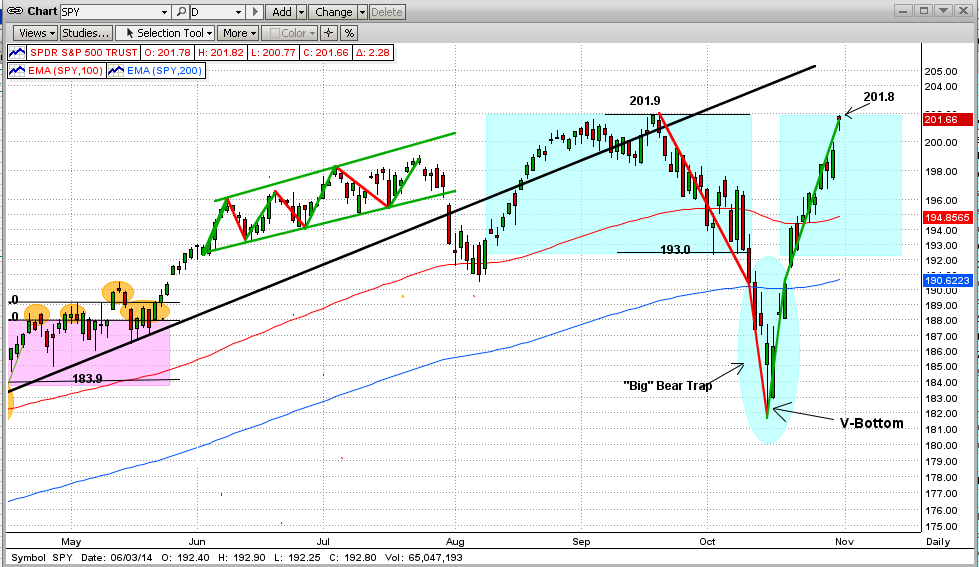
V-Bottoms
http://thepatternsite.com/patternz.html
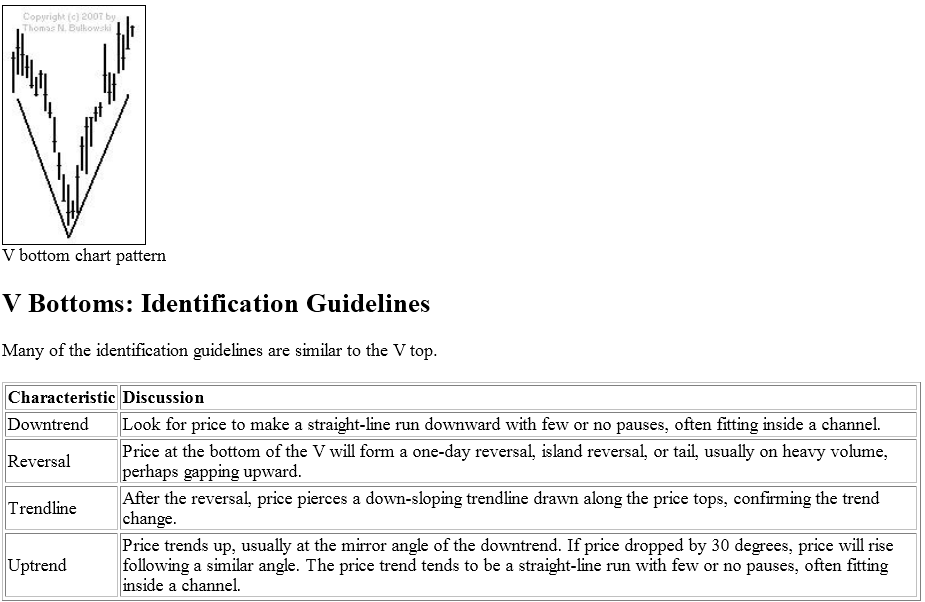
Friday, October 24 2014
Over the last few weeks/months, we have been asked many times,
1) Why is the recent MIPS trading frequency so low, and
2) Will the MIPS models react fast enough to catch real "market crashes" ??
First, the past trading history for the MIPS3 and MIPS4 models has been about 10-18 trades/year. But, the trading frequency of the MIPS models in the last two years has been the very lowest in the nine-year history of any of the MIPS models. This is basically because the market has been so strong recently (very strong up-trend) that it will take a lot of negative market action to get the MIPS models to change their direction. For example, when the market is lackadaisical, MIPS3 or MIPS4 may change direction with a 2-4% market dive, but at other times (like now) when the market has been super strong, even a 9% dive was not enough to get the MIPS models to change direction. In other words, the resistance of the MIPS models to a market change is somewhat "relative". Its kind of like comparing the condition of a really strong, healthy young man that falls off of a high cliff while hiking to the condition of his grandfather who fell of the same cliff at the same time. Most likely, the strong young man would be in a better condition a few days after the accident. [Of course, there are hundreds of other factors that determine a MIPS change, so don't just bank on "relative" changes.]
Second, the only real "live" experience we have with market crashes in the U.S. markets was during 2008-09 (actually, the eighteen months from 12/01/2007 - 05/30/2009). See the graph immediately below, with MIPS "trades" shown as red dots on the graph (during this time, MIPS3 traded 21 times or approx 14 trades/year). You will see that MIPS3 went short well before much downside damage had been done, and the model performed brilliantly during this entire period. Believe it or not, backtest results show that MIPS4 would have done even better !!!
MIPS3 +130% SPY -38%
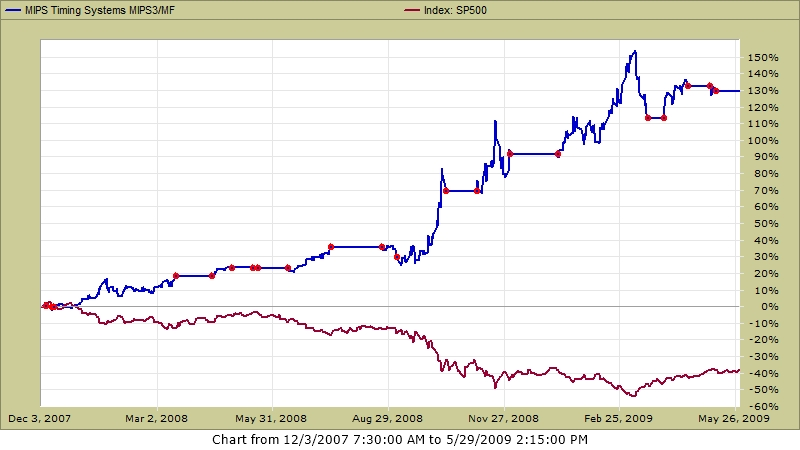
For the record, the actual, live trades from TimerTrac.com for this period are shown below.
TimerTrac.com
Trades for the strategy MIPS Timing Systems MIPS3/MF between
Saturday, December 1, 2007 and Saturday, May 30, 2009.
Times are mountain time, MST (GMT -7) / MDT (GMT -6).
* Note: For this strategy, any trades within the last 30 days are not shown.
| Date |
Distribution |
Percentage |
Comment |
| 12/6/2007 5:10:00 PM |
Mips Long |
100 % |
|
|
Mips Short |
0 % |
|
|
MMF |
0 % |
|
| 12/11/2007 5:10:00 PM |
Mips Long |
0 % |
|
|
Mips Short |
0 % |
|
|
MMF |
100 % |
|
| 12/12/2007 5:10:00 PM |
Mips Long |
0 % |
|
|
Mips Short |
100 % |
|
|
MMF |
0 % |
|
| 3/14/2008 5:10:00 PM |
Mips Long |
0 % |
|
|
Mips Short |
0 % |
|
|
MMF |
100 % |
|
| 4/11/2008 5:10:00 PM |
Mips Long |
100 % |
|
|
Mips Short |
0 % |
|
|
MMF |
0 % |
|
| 4/29/2008 5:10:00 PM |
Mips Long |
0 % |
|
|
Mips Short |
0 % |
|
|
MMF |
100 % |
|
| 5/15/2008 5:10:00 PM |
Mips Long |
100 % |
|
|
Mips Short |
0 % |
|
|
MMF |
0 % |
|
| 5/19/2008 5:10:00 PM |
Mips Long |
0 % |
|
|
Mips Short |
0 % |
|
|
MMF |
100 % |
|
| 6/11/2008 5:10:00 PM |
Mips Long |
0 % |
|
|
Mips Short |
100 % |
|
|
MMF |
0 % |
|
| 7/15/2008 5:10:00 PM |
Mips Long |
0 % |
|
|
Mips Short |
0 % |
|
|
MMF |
100 % |
|
| 8/22/2008 5:10:00 PM |
Mips Long |
100 % |
|
|
Mips Short |
0 % |
|
|
MMF |
0 % |
|
| 9/4/2008 5:10:00 PM |
Mips Long |
0 % |
|
|
Mips Short |
100 % |
|
|
MMF |
0 % |
|
| 10/10/2008 5:10:00 PM |
Mips Long |
0 % |
|
|
Mips Short |
0 % |
|
|
MMF |
100 % |
|
| 11/5/2008 5:10:00 PM |
Mips Long |
0 % |
|
|
Mips Short |
100 % |
|
|
MMF |
0 % |
|
| 12/1/2008 5:10:00 PM |
Mips Long |
0 % |
|
|
Mips Short |
0 % |
|
|
MMF |
100 % |
|
| 1/7/2009 5:10:00 PM |
Mips Long |
0 % |
|
|
Mips Short |
100 % |
|
|
MMF |
0 % |
|
| 3/18/2009 5:10:00 PM |
Mips Long |
0 % |
|
|
Mips Short |
0 % |
|
|
MMF |
100 % |
|
| 3/31/2009 5:10:00 PM |
Mips Long |
100 % |
|
|
Mips Short |
0 % |
|
|
MMF |
0 % |
|
| 4/17/2009 5:10:00 PM |
Mips Long |
0 % |
|
|
Mips Short |
0 % |
|
|
MMF |
100 % |
|
| 5/6/2009 5:10:00 PM |
Mips Long |
100 % |
|
|
Mips Short |
0 % |
|
|
MMF |
0 % |
|
| 5/8/2009 5:10:00 PM |
Mips Long |
0 % |
|
|
Mips Short |
0 % |
|
|
MMF |
100 % |
|
Copyright © 1999-2014 TimerTrac.com. All Rights Reserved.
Thursday, October 16 2014
The short-term view of the market looks terrible and simply could not look much worse. In the last 3 weeks the SPY has fallen about 9% from its all-time high of $201.9, broke through the bottom of its most recent trading pattern, broke through both the 100-day and 200-day EMAs, etc. Like I said, couldn't be much worse. One good note yesterday (Wednesday) was that the price action in the 2nd half of the day could represent a "One Day Key Reversal" pattern, which usually identifies a short-term rebound.
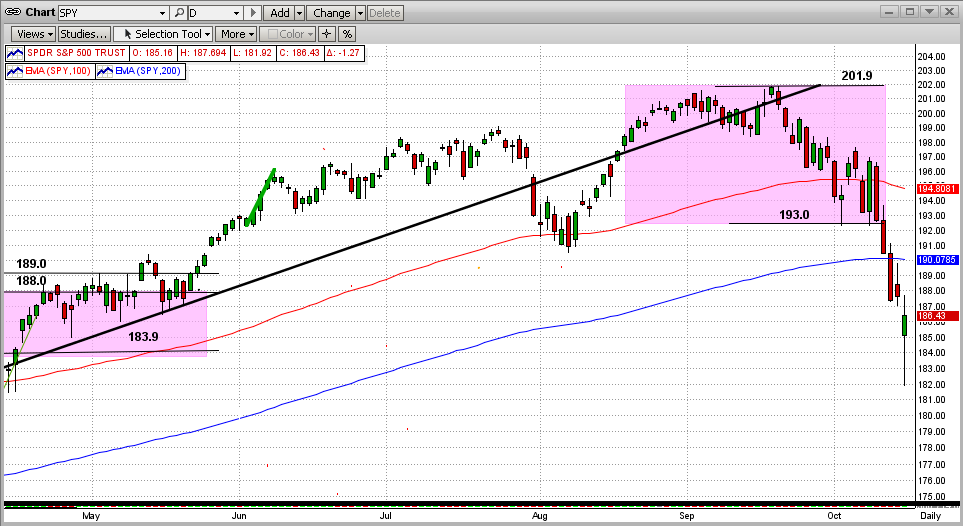
Should we be worried?
Remember, we are intermediate-term investors and not day traders. After the strong ride we have had in the stock market in the last 3-5 years, a short-term drop does not usually cause MIPS to signal a directional change in the stock market. [In other market conditions where the intermediate-term trend had only gained say 10-15%, a dip as small as 2-3% would catch MIPS' attention.] In other words, all changes in the price movement of the SPY are looked at by MIPS on a "relative" basis. For example, a 3% drop in a market that has been up 10% represents a 30% setback, whereas an 9% drop in a market that has been up 50% represents only an 18% setback. And, a market that grows 50% will recover a 9% setback quickly.
Long-Term View
There is one thing that investors need to concentrate on to become successful long-term investors. They must be able to somewhat ignore short-term (daily) gyrations in the market and put more emphasis on the long-term view. Looking at the monthly chart below, we can see that the disaster on the daily chart above is hardly noticeable on a monthly chart.
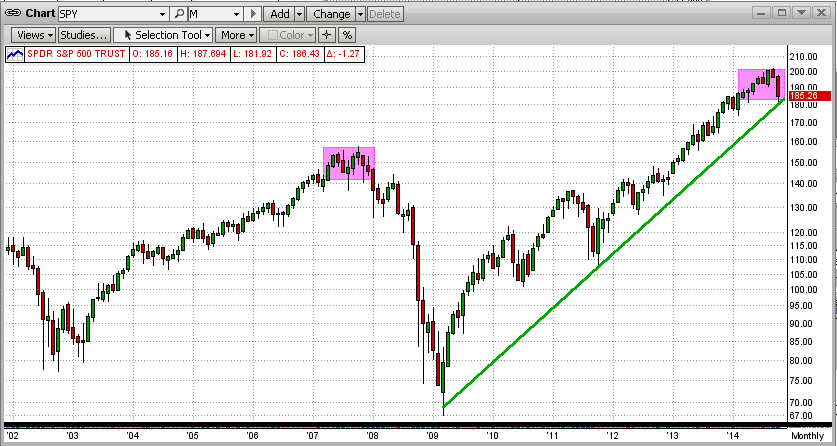
Topping Process
- Is the market topping?
The good news is that strong bull markets (4-6 years up) do not turn around easily or quickly. For this, let's look at the two most recent market "crashes", one in 2000 and the other in 2008. From the graph below, we can see that it took 8-10 months for these bull markets to give up and collapse. At this time, we are about 1/2 of the way through this process. Of course, the market in October could be the catalyst for the "Big One".
Our Goal
Our goal in MIPS is to capitalize on at least 80% of each major market crash. We do this by being willing to give up 10% on each end of the cycle to make sure that we capitalize on the other 80%).
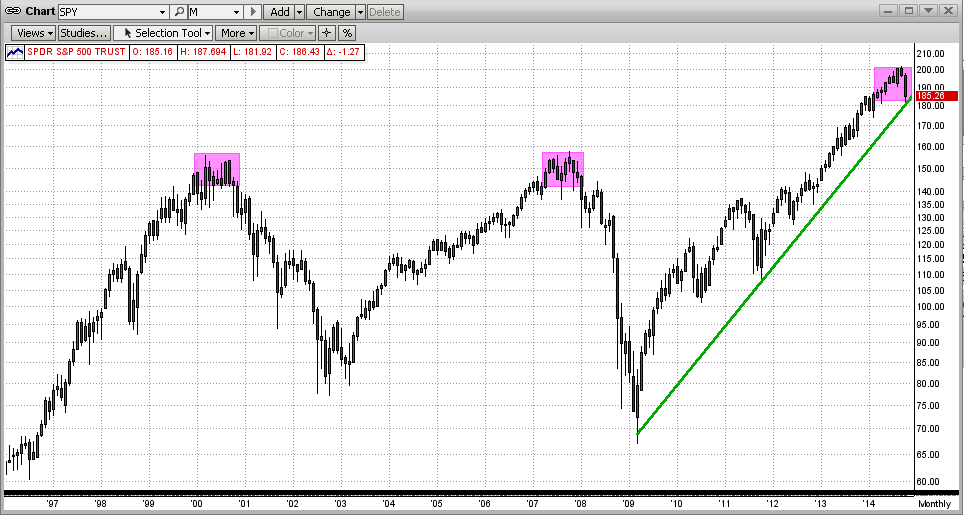
What if this is the beginning of the "Big One" ?
For that, we have to rely on MIPS. All of the MIPS models are now on the edge of going short, but they have not yet issued new short "Signals". Sometimes that is a blessing.
The MIPS models have been around since 2004, and the MIPS3/MF signals have been tracked by TimerTrac.com since 11/04/2005. During that time, we have had several intermediate-term downtrends and MIPS has profited from most of them (of course, MIPS also beats the SPY in up markets by detecting and shorting these intermediate-term downtrends).
We have had only one really big stock market "crash" in this 9-year timeframe from 2005 and that was from 4Q'07-2Q'09, when the S&P 500 dropped by over 50%. How did MIPS do in that market? For that, see the graph below for the period of the last big market crash using verified MIPS3/MF signals from TimerTrac.com.
MIPS3/MF +120% SPY -40%
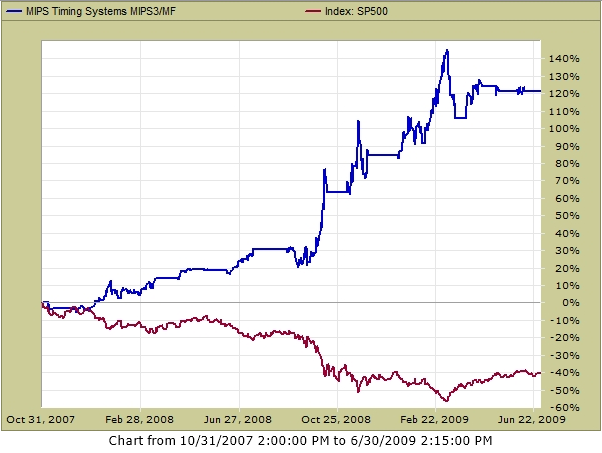
Thursday, September 25 2014
We all know that the stock market moves in "cycles", but many people cannot recognize them as such. To many investors, these cycles look like highly-volatile movements, but most really are just normal fluctuations. If you cannot decipher normal cycles as such and no more, you may not sleep well investing in the stock market. I personally learned how to do so over the years and thought that some of my tips may help you.
DAILY VOLATILITY
First, let's take a look at the moves in the SPY in the last few months (graph immediately below). The SPY movements in this graph are fairly representative of the last couple of years. Given that these "bars" represent your hard-earned money (retirement stash?), this can be unsettling. But, maybe it should not be. To see this more clearly, you need to step back a bit and look at it from a very different vantage point.
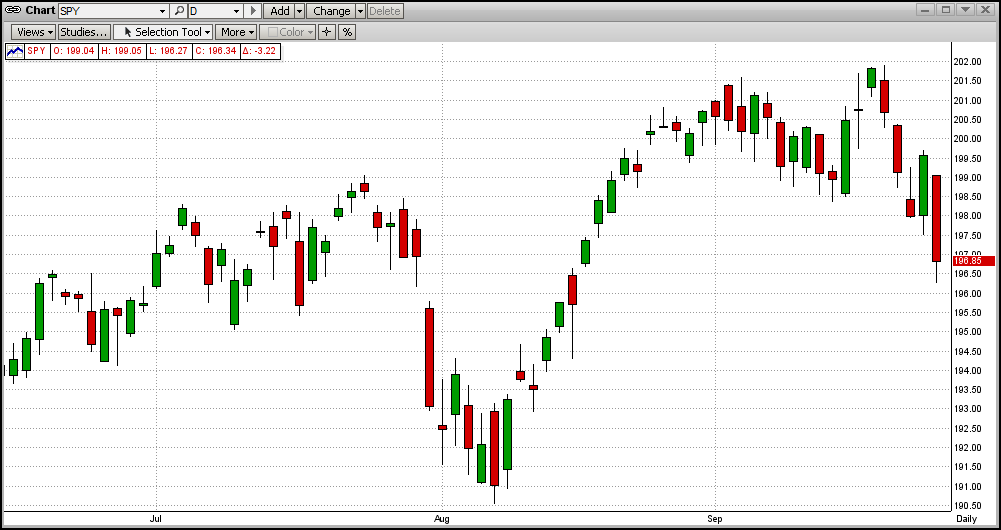
2-YEAR UPTREND
The graph below shows the price of the SPY since mid-Nov 2012 in a very different way (dark part). From this you can see a very definitive uptrend (white line). We all know that uptrends are made of higher-highs and higher-lows. The trendline in an up market is drawn along the bottoms of the higher-lows (just the opposite of being in a downtrend). Following the trend, this graph shows a 47% gain in the SPY (and, of course, in your money). BTW, if you had been trading 1/2 each of SPY/SH and SSO/SH (e.g., 1/2 double leverage on long signals), your gains would have been more like 65-70%.
Now, here is how you can sleep with this volatility: "Always consider the value of your portfolio to be the value on the trendline, no more". That is, do not consider the money above the trendline to be "your money" because the market is going to come back to the trendline over-and-over again until the trend runs its course. [What to do then is another topic in itself, and it entails knowledge and use of the MIPS models.]
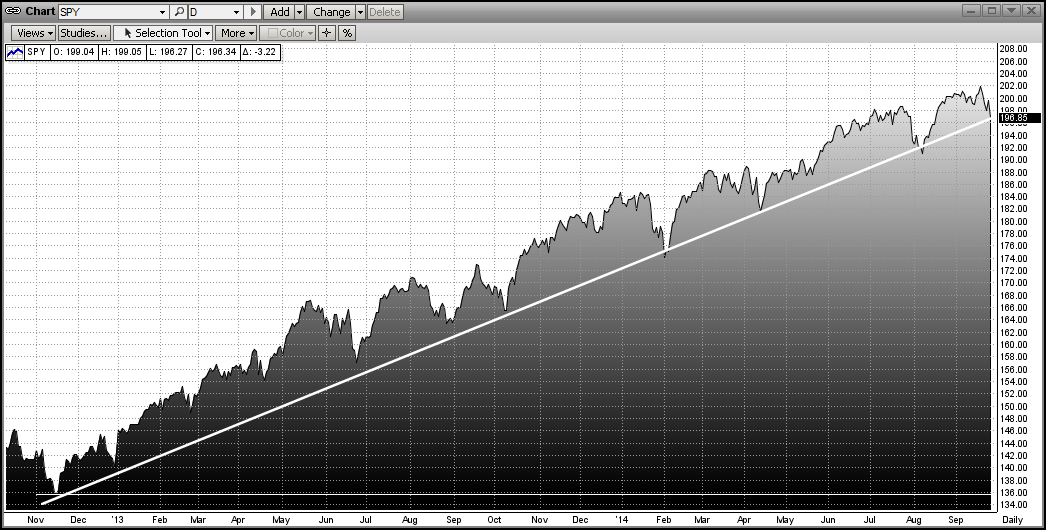
MONTHLY GRAPH
While you are enjoying watching the trend (and MIPS) making you money (or coming to an end), you can also sleep better at night along the way by looking at the same movements of the SPY on a weekly or even monthly basis. See the above trend on a monthly graph below (white trendline). Even if you look very carefully at the monthly graph below, you will NOT even be able to see the market volatility in the first graph above that kept you up at night. So, maybe you have been worrying about nothing !!!
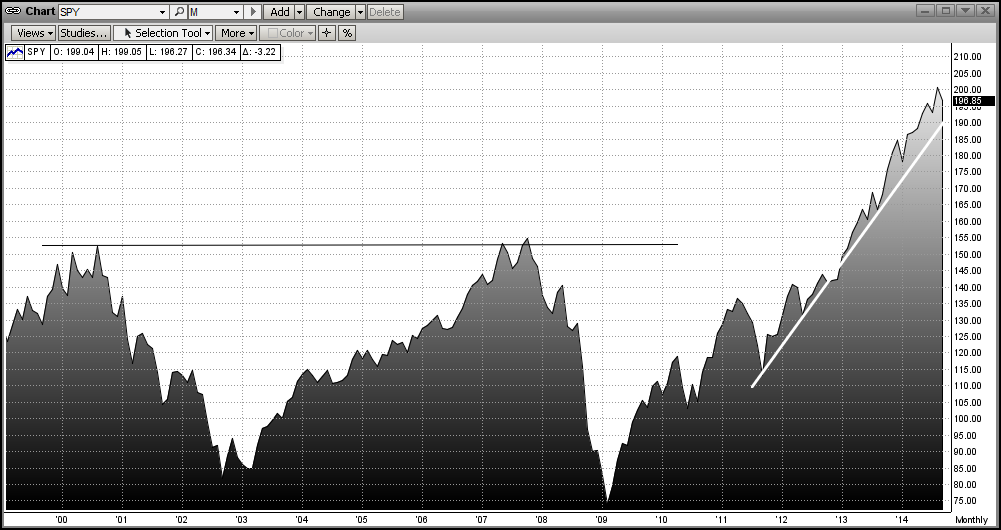
MIPS IN MARKET CRASH OF 2008
And again, don't be afraid of a market crash. Embrace it. Down markets are where MIPS should really make us big money, as it did in 2008 (see verified graph of MIPS3/MF trading SPY/SH from TimerTrac.com below).

Tuesday, September 23 2014
It is not really whether or not a market crash is coming, it's when. How do we know this? Because the big-bad-bear ALWAYS comes.
The very same "evidence" that Buy and Hold pundits (liars) use to prove that buy and hold works, actually proves that it does not !!! Their basic evidence is the "100 Year Dow" graph below. Upon close examination, starting with 1900-1920, you will see 20 good years followed by 20 flat/down years, over-and-over. BTW, being flat or "even" after 20 years is really a tremendous loss, because one would have doubled their money over 20 years with bonds paying only 3.6% !!!
From the graph below it would seem that, if people lived 100 years or more, the Buy/Hold liars may have a point. But most investors' prime "equity" investment years are from the time that they are say 45 years old (bought house, kids in college, career sound, etc.) until they are 65 years old (approaching retirement, need safe investments, more money in bonds, etc.). So, the prime time span for investors having a large portion of their portfolios in equities is about 20 years.
In the last 110 years, the 20 good/bad periods were:
Good 1900-1920 1940-1960 1980-2000
Bad 1920-1940 1960-1080 2000-????
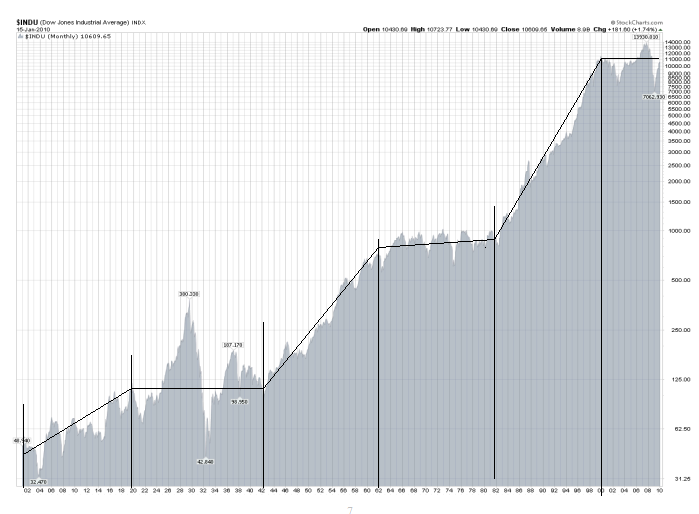
Almost everyone knows that the stock market in 1920-1940 experienced the biggest crash in the last 110 years, and we have personally "lived" through the market ups/downs in 2000-2013. But, what about the market in 1960-1980? For that, see the graph below. One could say that the graph speaks for itself.
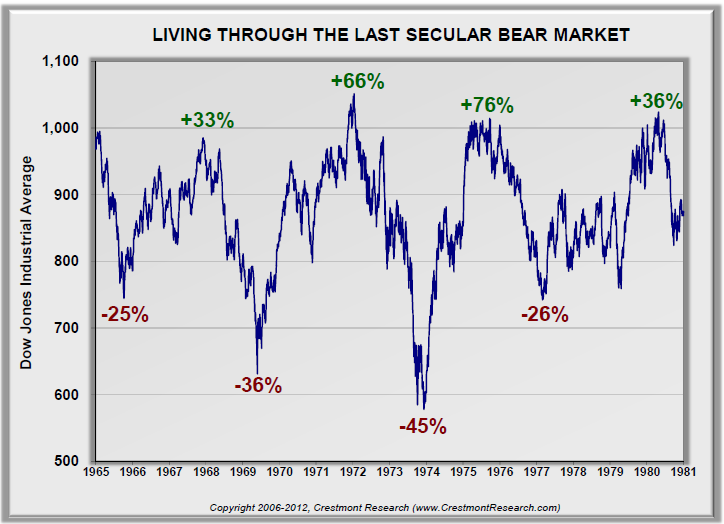
It should be obvious by now that this leaves the time period 2000-???? to dissect. Will we have another big drop? If so, when? And, how fast will the market turn down and will MIPS catch the turn? My experience has shown the market crashes that result from bad fundamentals change slowly (long bubbles like housing, etc.), whereas crashes that come from surprise "events" (like Lehman Bros.) change quickly.
See the graph between 2000-2013 below. We all know (unfortunately) that we have had two big market drops of over 50%. You will probably be relieved to see that, at the top, these markets traded in a range of (+ and -) 5% of their market tops for 9-10 months, before they headed down fast !!!
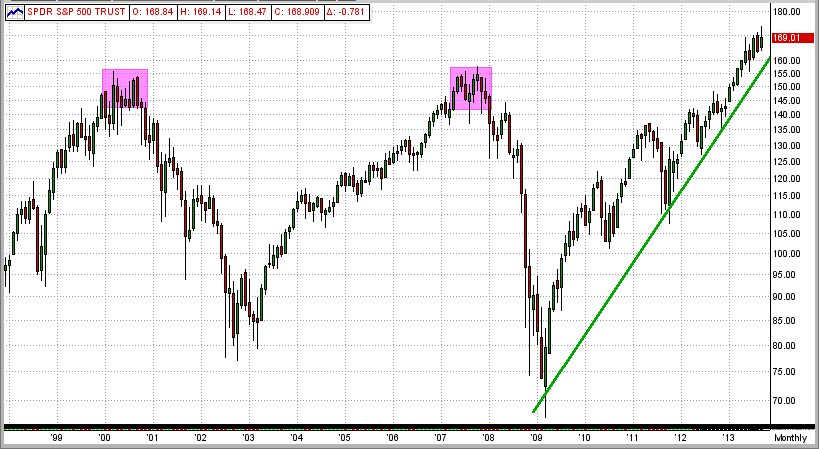
How did MIPS handle the BIG market crash of 2008?
- Well, it started with a short call on 12/12/07 for a 12% gain, followed by 4 other profitable short trades.
- Total gain of about +40% on the last 3 short trades between Sep'08 - Mar'09) !!!
- See graph below. What, me worry?
Legend: Red Boxes = Short Signals; Green Boxes = Long Signals; Yellow Boxes = Cash
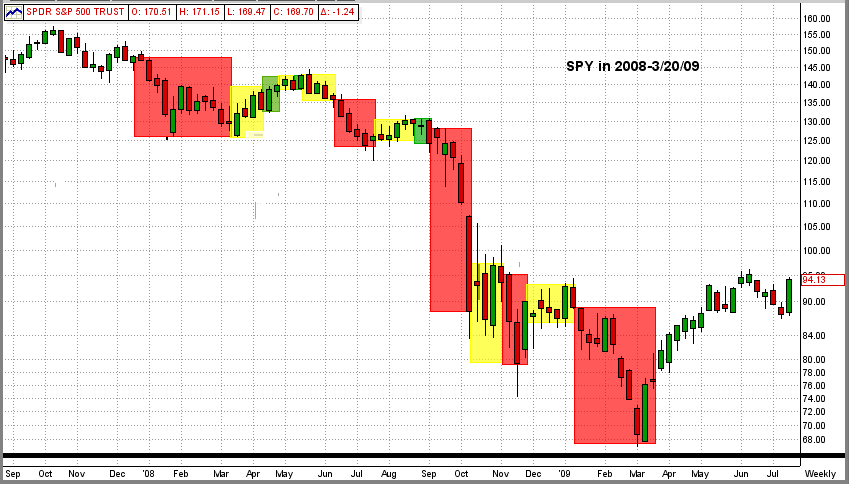
Graph below is the MIPS3/MF performance in 4Q'07 - 3Q'09 using "verified" trade signals on TimerTrac
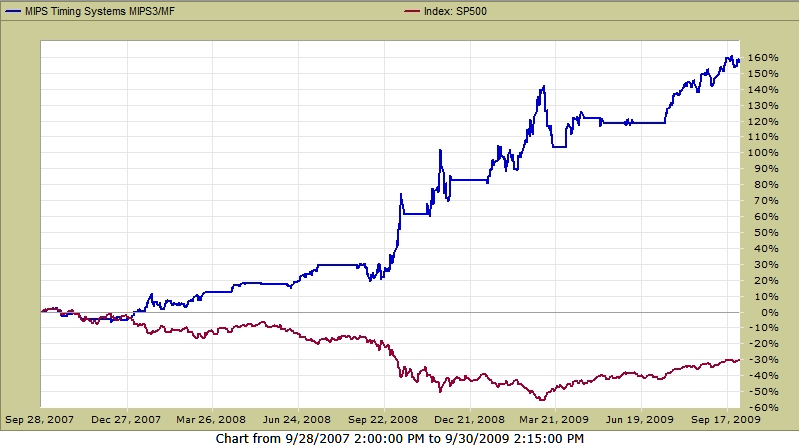
Tuesday, September 23 2014
We are pleased to report that we had a large number of respondents to our recent "Survey" email (see Survey email below). Most were very passionate and confident about their vote. And, many of our MIPS members are seasoned investors and/or professional money managers.
Rounding off to the nearest 5%, the final vote was:
UP DOWN Don't Know
65% 30% 5%
Thanks for your inputs...
- and remember, no matter what we think, we do not personally have to be right to make money in the market
- we just need to follow MIPS !!!
Feel free to contact me with questions (10am-8pm CDT, 6 days/week)
Paul Distefano
===============================================================================
<<< "Survey" email from 9/19/2014 >>>
MIPS - Survey: S&P500 3000 or 1000 ???
MIPS Members:
Of course, it is possible that this market will continue up at least until the S&P 500 reaches 3000. On the other hand, it is just as likely that the S&P 500 will collapse all the way down to 1000 or lower.
This market is similar to the market in 1995, where the Nasdaq had risen 10-fold in the prior years from 1985. In 1995, everyone was crying bubble, bubble, bubble and the Fed Chairman Greenspan coined the phrase "Irrational Exuberance" (meaning 100% emotional behavior). So, where did the market go from there? It continue up 6-fold from 750 to over 4500 in the next five years !!! [See our previous email below from May 11, 2013 entitled " History Repeats Itself, Like 1995 or 2000?"].
As one would expect, after the Nasdaq reached 5000 in the year 2000, the Nasdaq crashed big-time (65% drop) !!!
VOTE Up or Down in your email response
So, we would like your opinion as to whether we are:
1) in a market like 1995 where the market is going to continue up at least another 50% (to
a S&P 500 of at least 3000) or
2) in a market like 2000 where the market is going to crash at least 50% (to S&P 1000) ???
Thanks
Paul Distefano
=================================================================================
Saturday, 11 May 2013
As with almost everything in this world, the behavior of the stock market is made up of actions from millions of people. And, as with almost everything in this world, the stock market does kind of repeat itself. The $64,000 question is what is repeating and when?
This week I saw a talking head on CNBC discussing what was going on in the market and why, and if the current 5-year bull market would continue. Like most others, he gave a very nondescript answer. His short answer (and my interpretation of his answer) was that the action of the stock market would follow one of the options below:
1) Rational Exuberance - 60% (that is, keep going up as it should)
2) Irrational Exuberance - 30% (that is, going up faster, even though it should not)
3) Market Crash - 10% (that is, a complete reversal from today's bull market action).
This reminds me of three market behaviors of the Nasdaq in the 1990's (when Alan Greenspan coined the term "Irrational Exuberance").
Graph 1 - Rational Exuberance
This graph shows the Nasdaq from 1985-1995, when the index TRIPLED, but did so because technology was booming. This fits "Rational Exuberance" because everyone was happily making money on the high growth of companies like Microsoft, Oracle, Cisco, etc. In this 10-year period, the Nasdaq rose in value from about 250 to 775, ending with "overbought" conditions, nose-bleed P/E ratios (Cisco had a P/E ratio of over 100), etc. Then, the pundits were were crying, GET OUT!!!
Were they right?
 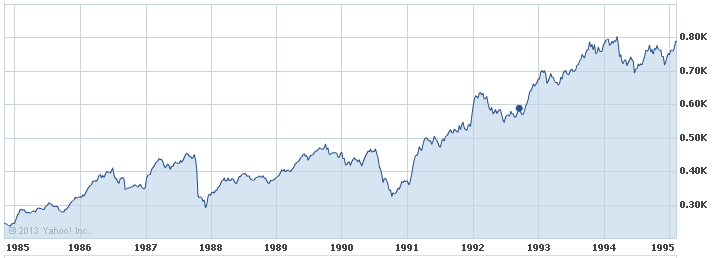
Graph 2 - Irrational Exuberance
Of course, the pundits were right about the fundamentals, but DEAD WRONG about the Nasdaq market performance
- the proof lies in the following 5 years performance [that is, in the time period of 1995-2999 (Graph 2)]
- this is when everyone (especially the little guys) went into panic buying ("Irrational Exuberance")
- the net result over this 5-year period was that the Nasdaq WENT UP OVER SIX-FOLD, from 775 to 5000, with
crazy things like Cisco's P/E ratio growing to over 400, Yahoo's market cap being more than the GDP of Iceland, etc.
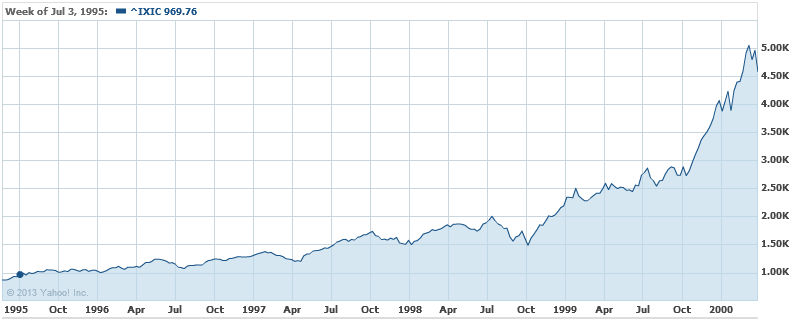
Graph 3 - Market Crash
We all know that US stock market indices went up in smoke after the year 2000, but getting out in 1995 was way too early.
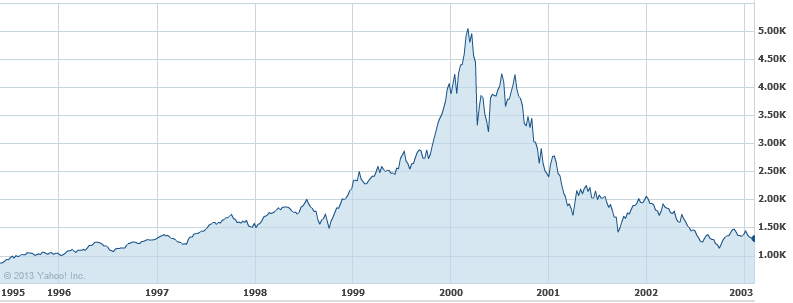
OUR POINT IS THAT SINCE THE MARKET DID RECENTLY BREAK TO THE UPSIDE AND SET NEW ALL-TIME HIGHS, AND IF THE BIG GUYS GET THEIR WAY, THE LITTLE GUYS CAN PUSH THIS MARKET WAY HIGHER THAN IT SHOULD GO (like 1995-2000), AND THEN THE BIG GUYS WILL DUMP BIG-TIME (like 2000).
BUT, IF THE LITTLE GUYS ARE NOT ABLE TO KEEP THE SPY ABOVE ITS CURRENT RESISTANCE LEVELS, THE BIG GUYS WILL MOST LIKELY SELL DOWN. OF COURSE, THIS CAN RESULT IN (1) A RELATIVELY SMALL DIP WITH A CONTINUED UPTREND, OR (2) A BIG MARKET CRASH (like 2000).
We certainly can't predict what will happen from here, and that is why we developed and follow the MIPS models. If and when this market makes a major change, MIPS will most likely miss a minor part of the change, but will find and follow the resulting trend. And, MIPS should ignore minor changes to prevent getting whipsawed.
Thursday, September 18 2014
Lots of action this week. Of course, Yellen is still doing everything she can to help the fat kats to get fatter. She claims that her efforts to drive interest rates to near zero are to boost the economy and to help the little guys, but we all know better than to buy that. If the Fed really wanted to help the little guys, it could have simply given each family in our country over $55,000 each (not practical, but we did print that much new money).
So, where did the money go? Of course, quantitative easing has helped the economy and the little guys some, but the real benefactors have been the top 1% who have funneled money to themselves en masse by borrowing hundreds of billions of $'s at near zero interest and "raking it in" with things like huge gains in higher-and-higher stock prices. For example, the process has been to:
(a) borrow at near zero interest,
(b) buy back company stock,
(c) profits/share go up because the number of shares go down, NOT because profits go up,
(d) stock prices go up both from the higher buying volume and the "higher" profits/share ratio,
(e) fat kats make big money on the higher stock prices of their personal shares, and
(f) fat kats get huge bonuses because "they" increased the profits/share.
And, there is still tons of money out there that has not yet found its way into the economy.
If will be very difficult for the stock market to collapse while this process continues and when there is really no other competitive place to invest big money with high liquidity.
See the graph immediately below:
What you see is the tail-end of a 19-month uptrend (black line), a breakout today to the upside from within a 3-week sideways trading pattern (pink rectangle), and a new high on the SPY at $201.70/share. Upside resistance is at the upper end of the green trading range, and downside support is at the 50-day EMA.
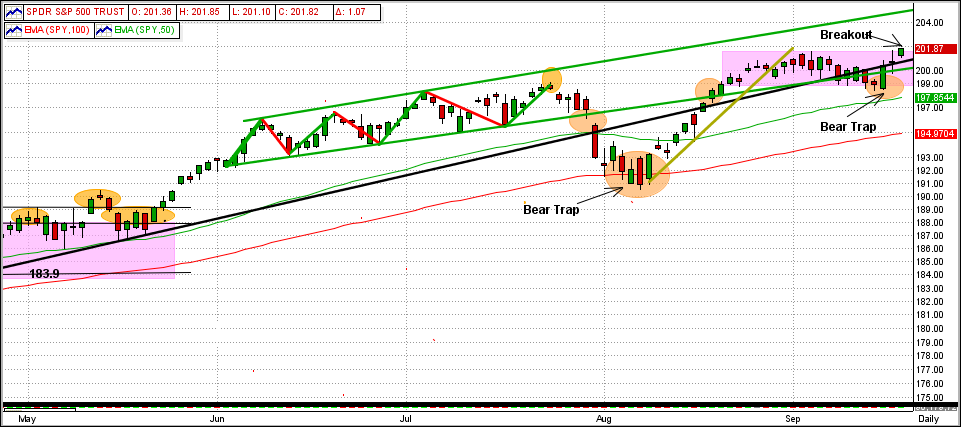
During this 19-month trend period, the number of MIPS3 trades has been very low due to the strong market uptrend (MIPS does not trade just to trade). The MIPS3/MF model usually trades 10-15 times/year, but it has only traded about 6 times since the end of 2012. More trades in a market like this usually result in getting whipsawed (as many other timing models have experienced).
So, how did MIPS3/MF perform during this time frame ???
See the graph of MIPS3 below trading 1/2 each of SPY and SSO on Long signals (1.5x leverage) and 100% SH on Short signals (no leverage). During this time, MIPS3 was up +54% !!!
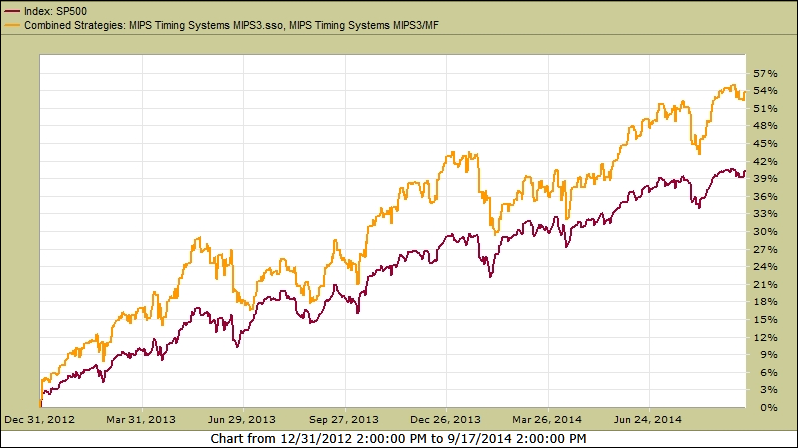
Wednesday, September 10 2014
This blog is an update to our previous 8/19/2014 email (shown below this current email). That was when the newest short-term trend, which started in late-May 2014, went into a big dip on 7/25/2014, and then started a recovery from this Bear Trap on 8/18/14, had just worked its way back into the green-line up-channel.
Since then, the SPY continued the up-trend for a few days (gold trendline) and then went into a 14-day sideways trading pattern (pink box). Today, the SPY "tested" the sideways pattern bottom (pink), the intermediate-term trendline (black), and the bottom up-channel trendline (green), and "held-the-line" on all three (see graph immediately below).
Legend:
Green Curved Line = 50-Day EMA
Red Curved Line = 100-Day EMA
Black Line = Intermediate-Term Trend Line
Green Lines - Short-Term Trend Lines
Purple Box = Sideways/Flat Trading Pattern
Orange Circles = Significant Points
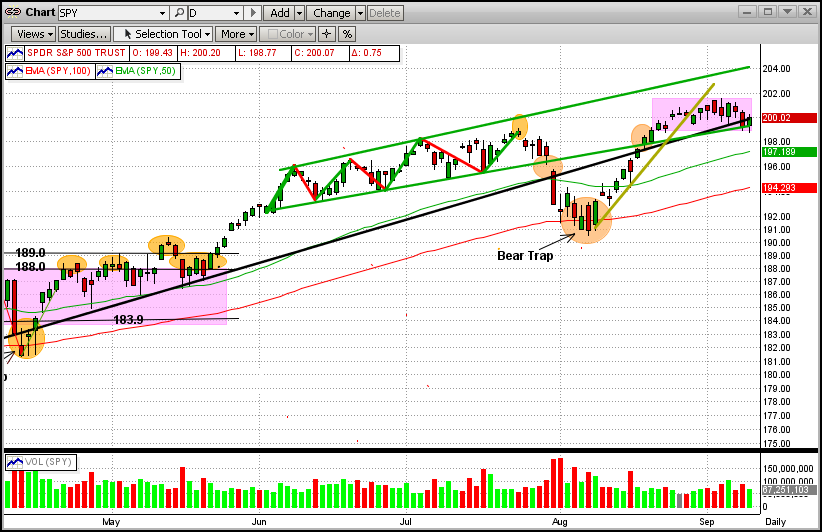
It is interesting that the majority of the times that a market goes into a sideways pattern, it breaks out the way that it went in (like now, the SPY entered the sideways trading pattern going up, so we expect it to break out to the upside). After that, the next upside goal is to break the upper trendline in the green up-channel trading range. On the downside, the SPY has support at both the 50-day EMA and the 100-day EMA (the latter of which lies about 3% below today's close).
The odds are for the uptrend to continue (the MIPS models all remain long at this time). We all know that this can change at any time and believe that MIPS will get us out when it does. So, sleep well.
Tuesday, August 19 2014
8-19-2014
This blog is all about the latest short-term trend in the market, which started on 5/22/2014 with a breakout of the SPY after a 2-1/2 month sideways/flat market (remember "No Man's Land" in the purple box below). Of course, this is the tail end (so far) of a strong intermediate-term uptrend that started almost 2 years ago in Nov 2012 (black line). See the graph below.
Legend:
Green Curved Line = 50-Day EMA
Red Curved Line = 100-Day EMA
Black Line = Intermediate-Term Trend Line
Green Lines - Short-Term Trend Lines
Purple Box = Sideways/Flat Trading Pattern
Orange Circles = Significant Points
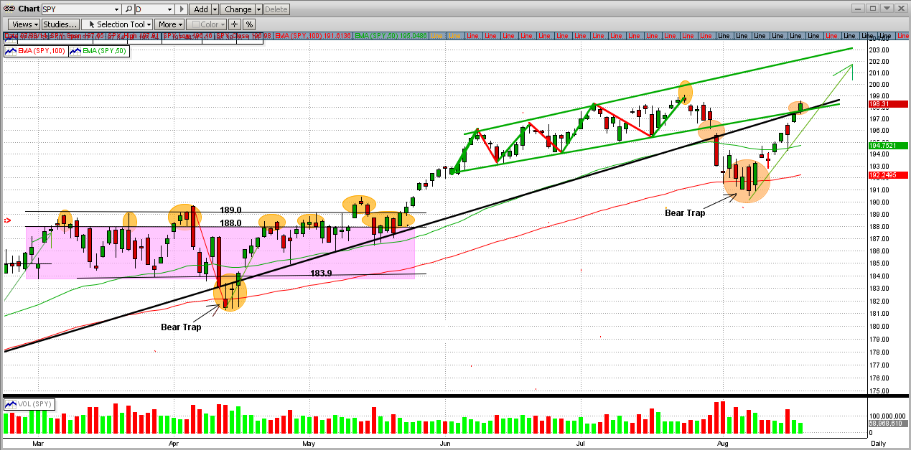
We are most interested in the pattern that started developing at the beginning of June 2014. This has evolved into what is called an "up channel". Swing trades will trade this as follows: Buy when the SPY hits the bottom channel line and Sell when it hits the upper channel line. Some very experienced swing traders can make money at this, but most amateurs get crushed (surprise, surprise). Most of the time, trading these patterns leads to getting whipsawed badly. For most investors, it is best to ride the uptrend by staying long (or short in downtrends).
The market (the SPY) traded in this range almost to perfection until the 3rd week in July when it failed to "hit" the upper trendline, and then it fell 4.3% over the next 2 weeks (from about 199-190). Also, during that fall, the SPY broke both its 50-Day EMA and 100-Day EMA. Of course, this caused many traders to go short, only to get whipsawed with a quick reversal a couple of days later. MIPS dodged this "Bear Trap" and stayed long. At the close today, MIPS was under its all-time high price by only 1/3 of 1% !!!.
For the uptrend to be re-established, the SPY will need to climb above its all-time high of $199.1 (on 7/21/2014). If it does we, along with 200 million other investors in the US stock markets from all over the world, will make more money on this uptrend (even better if you have a percent of your money in double leverage, like the SSO). Better yet, if the market does tank, we (along with a relatively few individual investors that "short" like the hedge fund managers do) will make lots of money. So, don't be afraid of the "Big One". Hope for and embrace it !!!
Sleep Well !!!
Remember what MIPS did in 2008?
- If not, see below
Red=Shorts, Green=Longs, Yellow=Cash

MIPS in 2008 (from TImerTrac.com)
- look forward to repeating something similar to that below

Sunday, August 03 2014
August 3, 2014
At the end of last week, we had a large number of members asking "Is this the beginning-of-the-end of our 5+ year bull market"? Of course, this was prompted by last week's terrible market performance.
Before we go too deep, let's take a look at some recent market action of the SPY (ETF for the S&P 500). (Remember, the SPY's price is about 1/10th of that of the S&P 500.)
Look at the 1st Graph below (SPY).
In this recent time period, the last 6 trading days were bad. But how bad is bad and where does it take us?
- The SPY dropped almost 4.5% in the last 6 trading days in the graph below.
- On the last day in the graph below, the SPY broke down through the 100-day EMA and the long-term trendline.
- On the day before that, the SPY had one of its worst one-day drops in over a year (-2% in one day).
1) Does the price action of the SPY (steep drops) upset you?
2) Are you having trouble sleeping because of it?
3) Do you think that this the beginning of a real Bear Market?
4) How far do you think the SPY will drop from here?
5) Are you ready to "override" the MIPS long signal and go to cash or short?
1st Graph
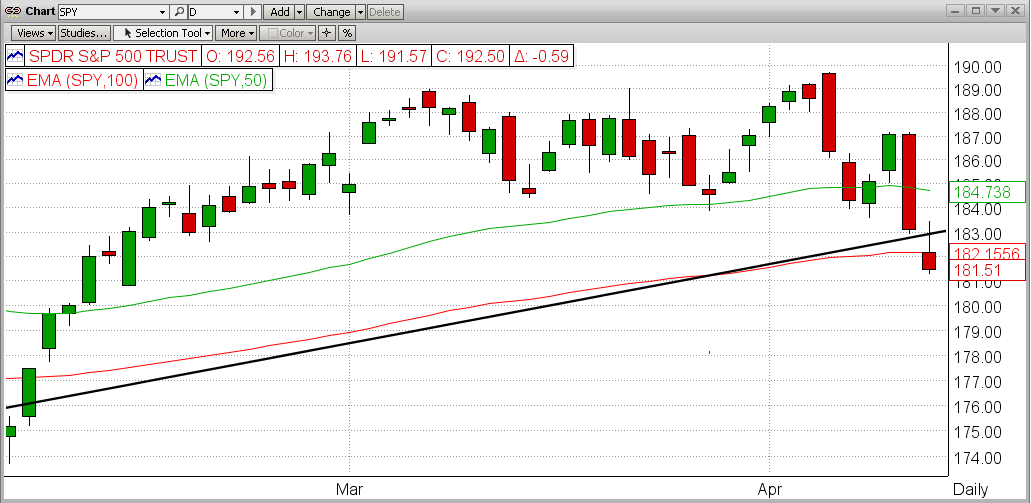
Usually when we look at price action graphs, I try to explain what I think happened and what might happen from here on. Well, this time I know 100% what happens next. Yes 100%, and guaranteed. And no, I have not lost my mind nor do I think that I have somehow acquired divine status.
This reason that I can make this iron-clad guarantee is that the graph above (that looks so much last week's price action) is actually from 4/11/14 (3-1/2 months ago). From that exact day, the SPY reversed itself and continued up (+8.5%) until 7/30/14. See Graph #2 below.
Graph #2
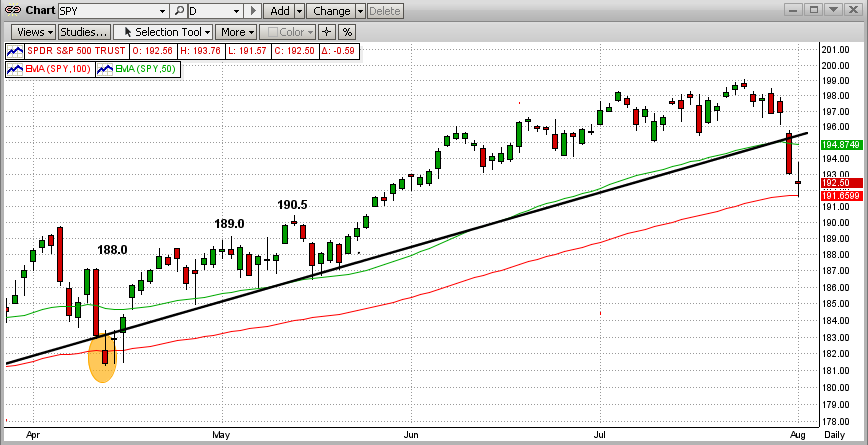
Now how do you feel about the price action in Graph #1 from 4/11/14? Now that you have seen a nice recovery and more up-side gains, your fear and confusion most likely just sank into a sinkhole. So, are we through with those kinds of scares. Heck no, and the market is no place for the weak of heart or mind (unless, of course, you have MIPS covering your back).
Let's truly visit what we thought we were looking at in the very beginning of this blog - the price action of the SPY last week (see Graph #3 below). Do you see the resemblance of this graph that goes through 8/01/14 to that in Graph #1 that goes through 4/11/14? The markets do repeat themselves.
Graph #3
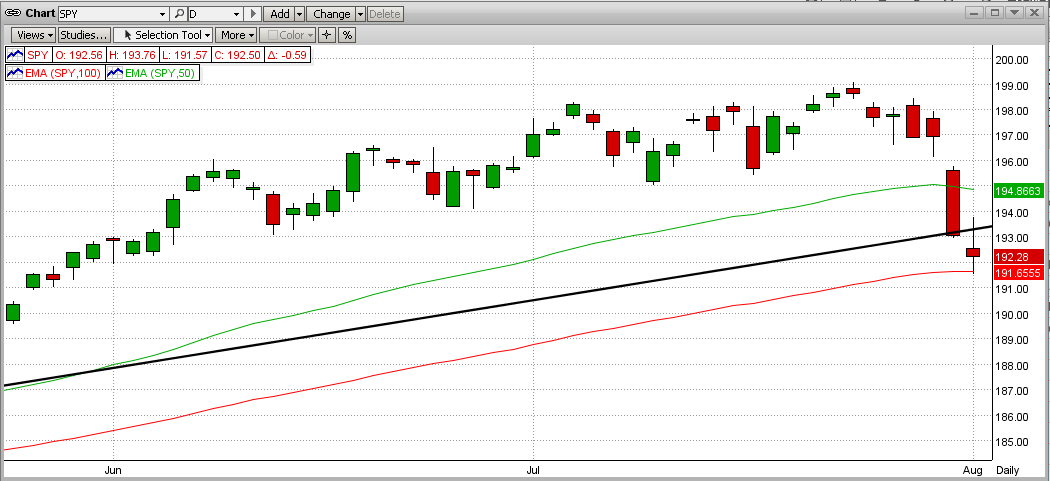
Now we can go back to our old way of playing the game. Where do we go from here? We believe that there is just as good a chance of the market turning around and heading back up (as it did 8-10 times in the last 20 months - Graph #4 below) as of it heading down into a large correction or a real bear market. Each of these scenarios have credibility and each is possible.
But, that is just what we think. MIPS is looking at this from a completely different angle. I can say that some of the MIPS models are on the brink of going short, but one or two up-days can change that. Let's keep a close eye on changes in the MSI and watch for MIPS signals.
Graph #4
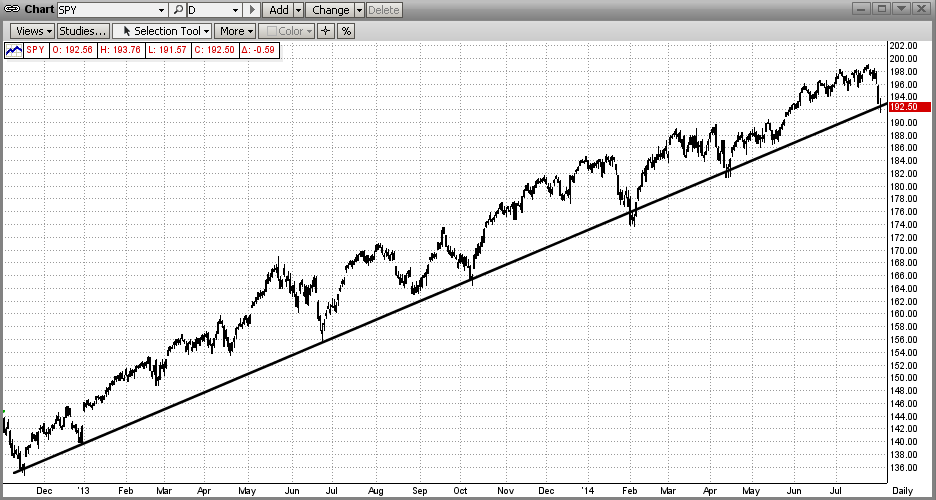
Hope this helps !!!
|